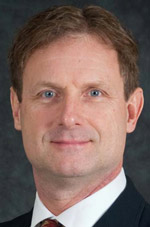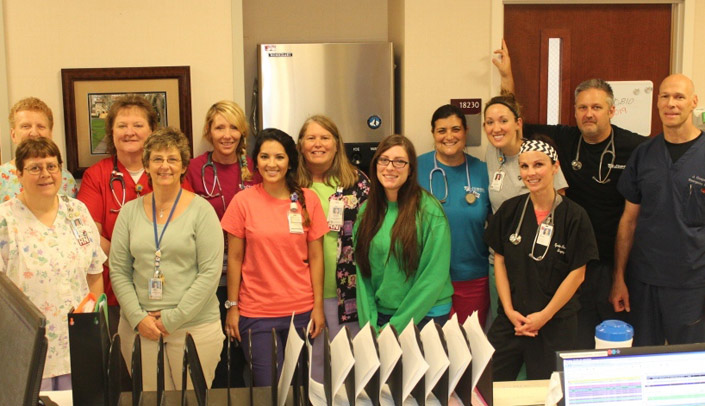The merger 17 years ago that brought together UNMC’s University Hospital and Bishop Clarkson Regional Medical Center created a new kind of hospital — one with deep roots in the community, a background in internationally acclaimed research and a focus on treating the sickest and most critically ill patients in the region.
Education, research play role in ED success
Education and research also play important roles in providing extraordinary care to emergency department (ED) patients. The Section of Emergency Medicine became The Department of Emergency Medicine at The University of Nebraska Medical Center in 2007. It includes 22 faculty members and 27 resident physicians. Each year, nine new residents enter the three-year residency program, which includes rural rotations in North Platte, Fremont and Norfolk. The department also ranks in the top half of academic emergency medicine departments when it comes to research funding.
 |
Robert Muelleman, M.D. |
All of the emergency medicine faculty are board certified in emergency medicine, and some are also involved in toxicology, hyperbaric medicine, point of care ultrasound and EMS programs. Faculty members provide medical direction for the hyperbaric program at the med center and the Nebraska Poison Center. The department also has the only EMS fellowship trained and EMS-board certified physician in Omaha.
“This wouldn’t be possible without the hard work and dedication of our physicians, nurses and other staff members,” Dr. Muelleman said. “The ED can be a stressful and chaotic environment at times, but they always handle difficult situations with the utmost professionalism. The role of the ED within the health care system continues to evolve, and we will continue to evolve our practice to meet the needs of our patients and medical staff.”
The front door for many patients was through the emergency department (ED). Last week, The Nebraska Medical Center and its partner hospital in West Omaha, Nebraska Orthopaedic Hospital (NOH), treated their one millionth emergency department patient since the merger.
Clinical manager Suzanne Watson said the staff was surprised when they heard the figure.
“They’re focused on caring for each individual patient,” Watson said. “They don’t think of them as a number.”
In the years after the merger that brought Clarkson and University Hospitals together, there were still two separate EDs downtown and a freestanding ED in West Omaha.
“When we merged, the nursing staff would go back and forth between University and Clarkson,” Watson said. “The physicians staffed all three locations.”
Before long, it became clear a newly joined hospital would need a central emergency department. The current ED at The Nebraska Medical Center opened in 2005 and continues to be a hub of activity.
“I thought the number might be two million based on how busy we’ve become,” said longtime emergency department nurse Mike Diggins. “Medicine is so much more complicated than it was 28 years ago when I started here.”
Nebraska Orthopaedic Hospital opened in 2004 as Nebraska’s first and only specialty orthopaedic hospital. It took over operations of the emergency room of what was then known as Clarkson West Hospital in 2010.
“Whether it’s a broken bone, sprained ankle or cut that needs stitches, our staff is ready 24/7 to handle any situation,” said Tom Macy, CEO of Nebraska Orthopaedic Hospital. “Our strong partnership with The Nebraska Medical Center has provided a convenient emergency department service for residents of West Omaha.”
The two EDs see a combined total of approximately 60,000 patients per year — about 10,000 at NOH and 50,000 at the med center. Since July 1, the med center’s ED patient volume has increased about 10 percent.
“We have a great team here,” Diggins said. “That’s why I work at the med center and not anywhere else.”
